From fiery tteokbokki to funky kimchi, there’s nothing timid about Korean food! And these 27 Korean recipes prove that you shouldn’t be intimidated about cooking authentic Korean cuisine at home. Let’s have a look at everything from banchan to Korean dessert (and all stops in between).
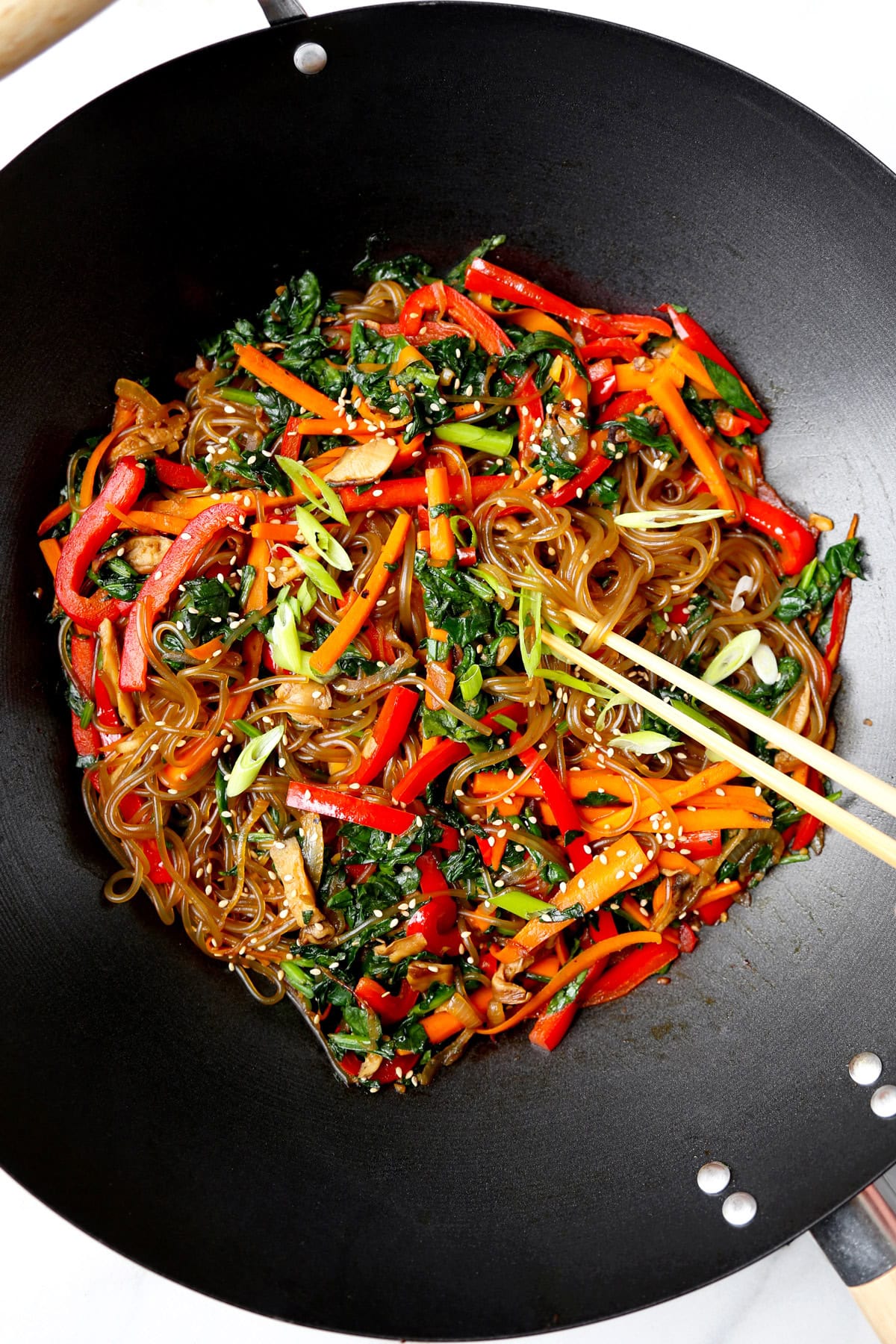
There’s nothing better than heading to your favorite Korean BBQ joint. Because, even if you’re not hungry when you walk in, the delectable aromas coming from the kitchen and the in-table grills will send your appetite into overdrive.
My favorite moment is when the banchan starts to arrive.
What is Banchan?
Banchan translates roughly into side dishes. These are the myriad small plates that arrive at your table after you’ve ordered, but before the main courses arrive. And you might get anything from dried anchovies to mung bean jelly to pickled radish.
However, although they tend to arrive at the table at the beginning of your meal, they’re not really appetizers. Think of them as snacks meant to be enjoyed on their own – or as a condiment throughout your entire meal.
But Korean cooking is so much more than tiny appetizer portions of kimchi, bean sprouts and seasoned fish cakes.
Some Iconic Korean Recipes
Below you’ll find recipes for classics like japchae (Korean glass noodles), tteokbokki (spicy rice cakes), bibimbap (mixed rice bowls) and dak bulgogi (Korean grilled chicken). And don’t worry if you’re not familiar with those yet! Korean food is super accessible. Plus I’ve got spicy stews, cold noodle soups and Korean dumplings.
Here are 27 of my favorite easy Korean recipes you can make in your home kitchen with pictures, step-by-step instructions and even a few videos.
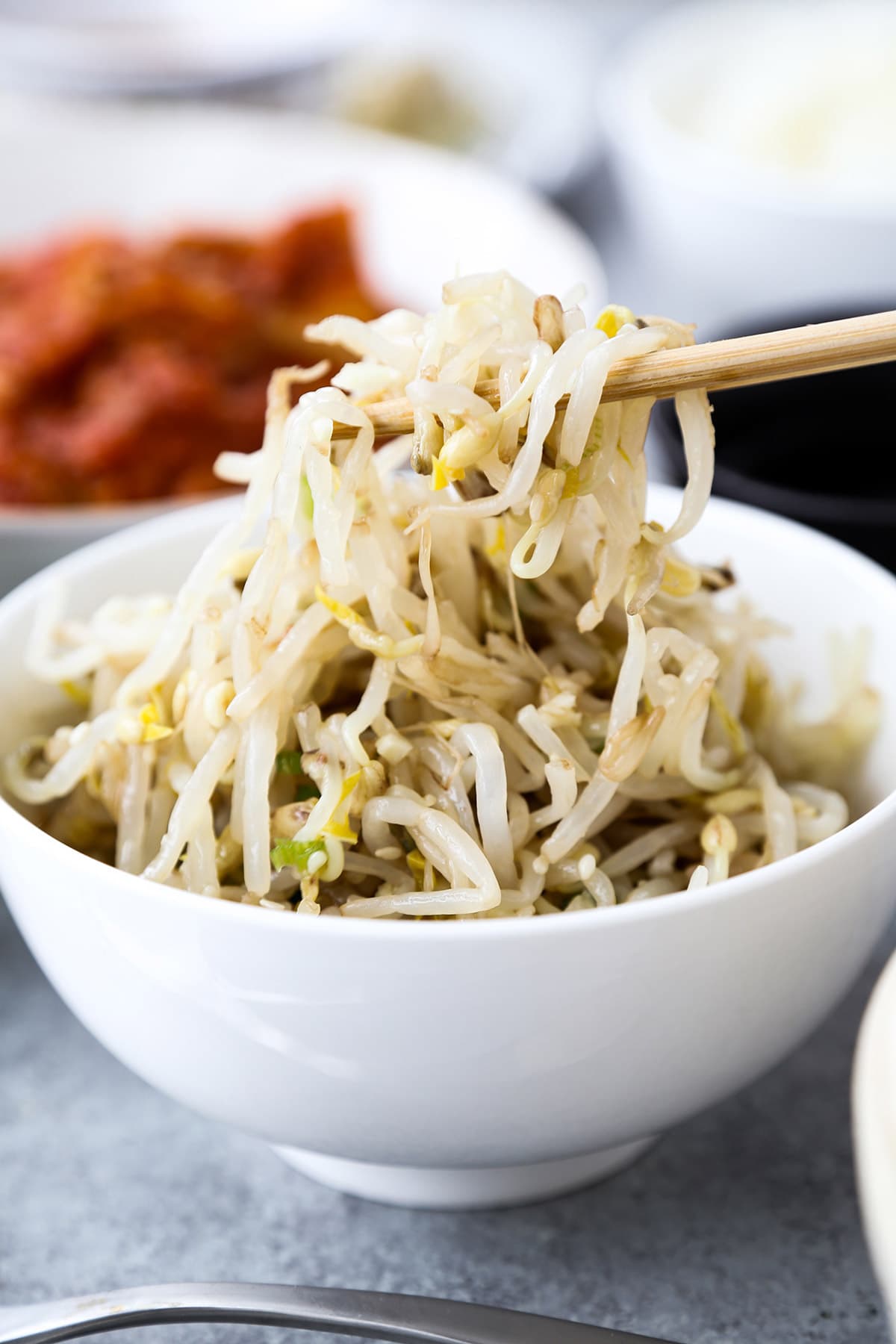
Korean Bean Sprout Salad (Sookju Namul)
This is one of those essential Korean side dishes, served at restaurants as banchan and as a topping for things like bibimbap. You can use mung bean sprouts or the more traditional soy bean sprouts – whatever you’ve got handy. Mildly savory, nutty and refreshing – and ready in 10 minutes.
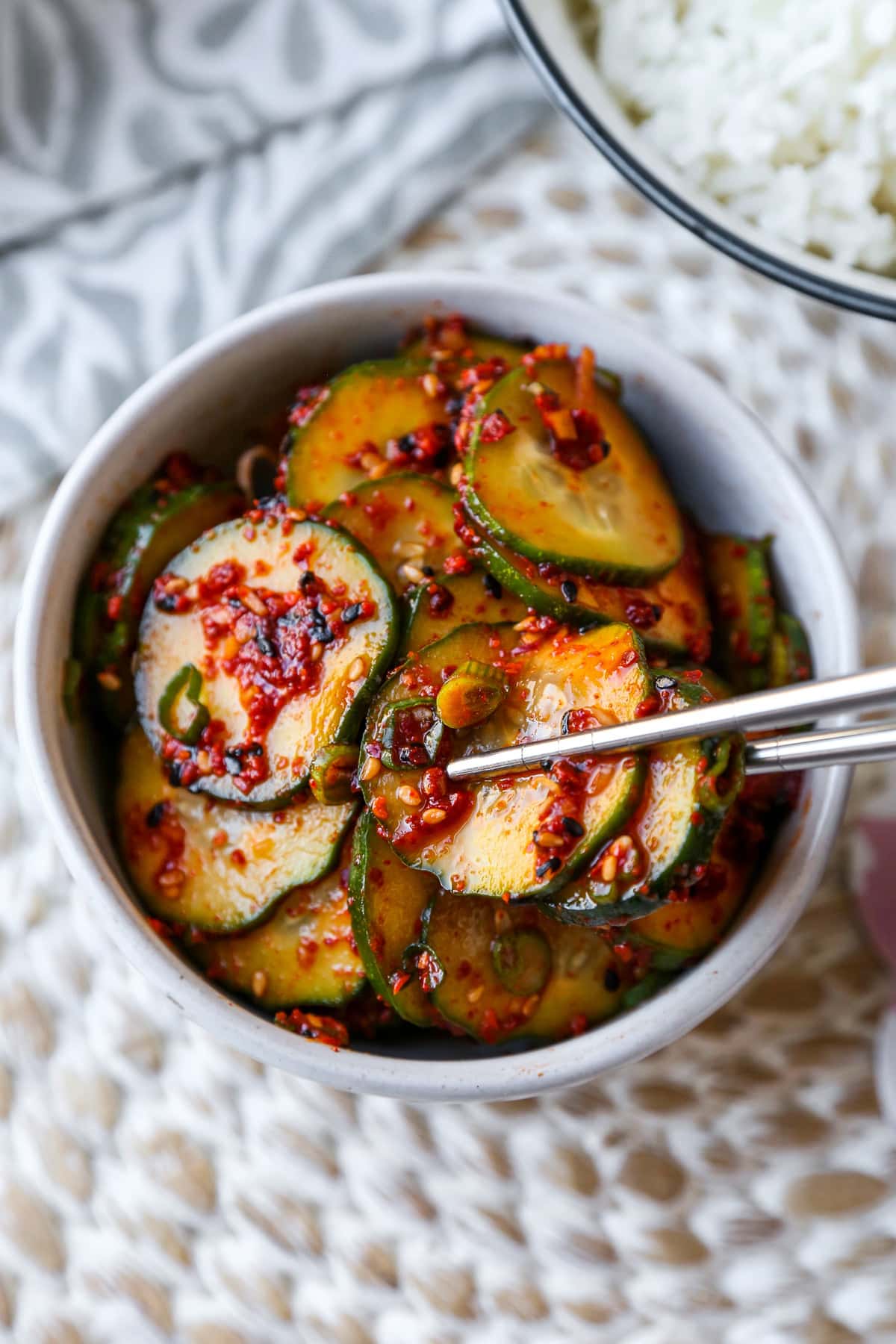
Korean Cucumber Salad
Oi muchim in Korean translates roughly to ‘seasoned cucumber.’ However, that doesn’t come close to describing the spicy, tart, savory, smoky and slightly sweet flavor bomb these seasoned cucumbers deliver. Use kirby cucumbers for the best crunch (English cucumbers work as well).
Cucumber Salad – Oi Muchim Recipe Video
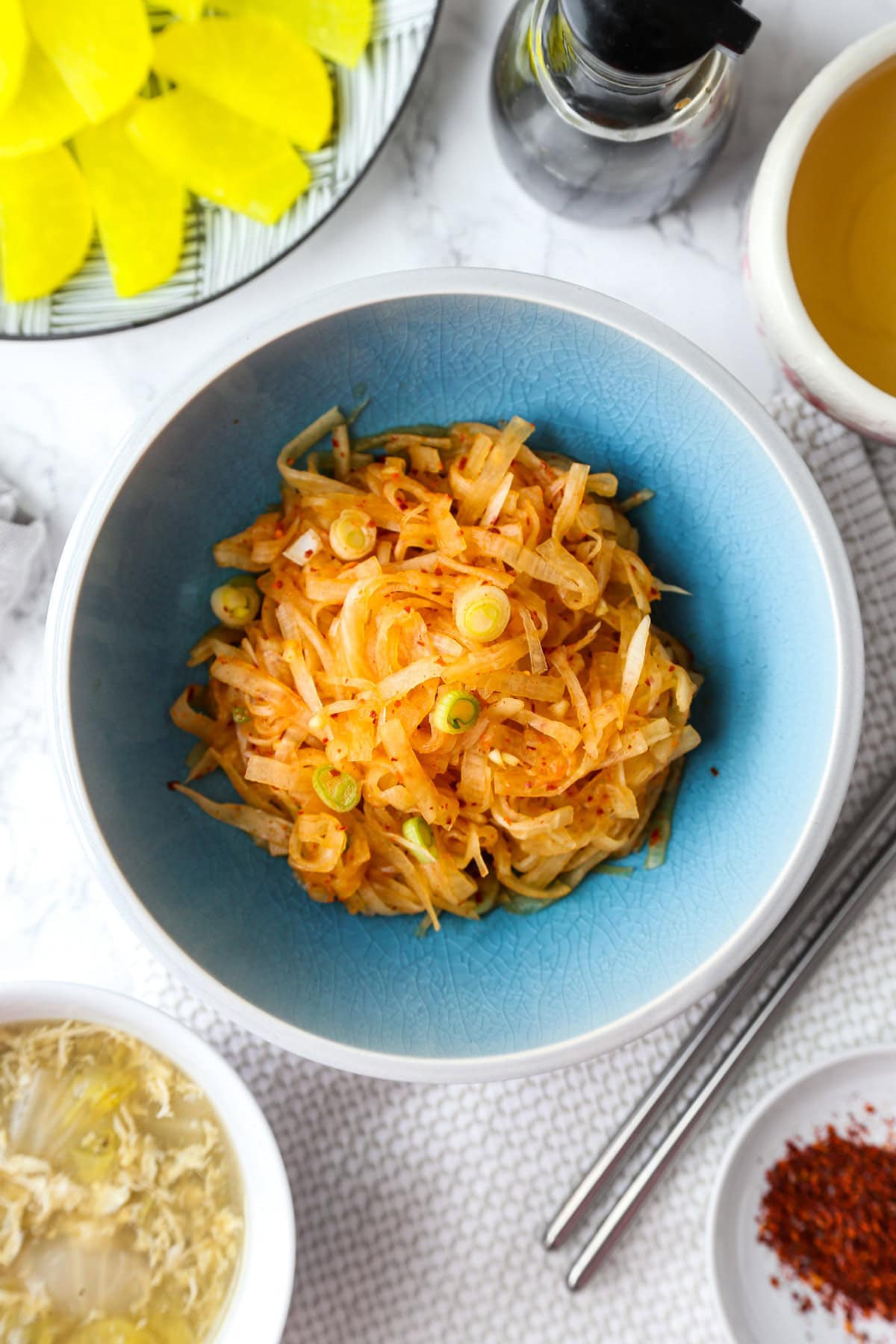
Korean Spicy Daikon Radish Salad (무생채)
Daikon radish comes up a lot in Korean recipes. That’s because it’s so versatile. And it’s pretty amazing to experience the bold flavors daikon, green onions, fish sauce, sesame oil and pepper flakes can produce. While this salad isn’t quite as well known as something like kimchi, it’s the first banchan I hope for at Korean restaurants – and I make it at home all the time.
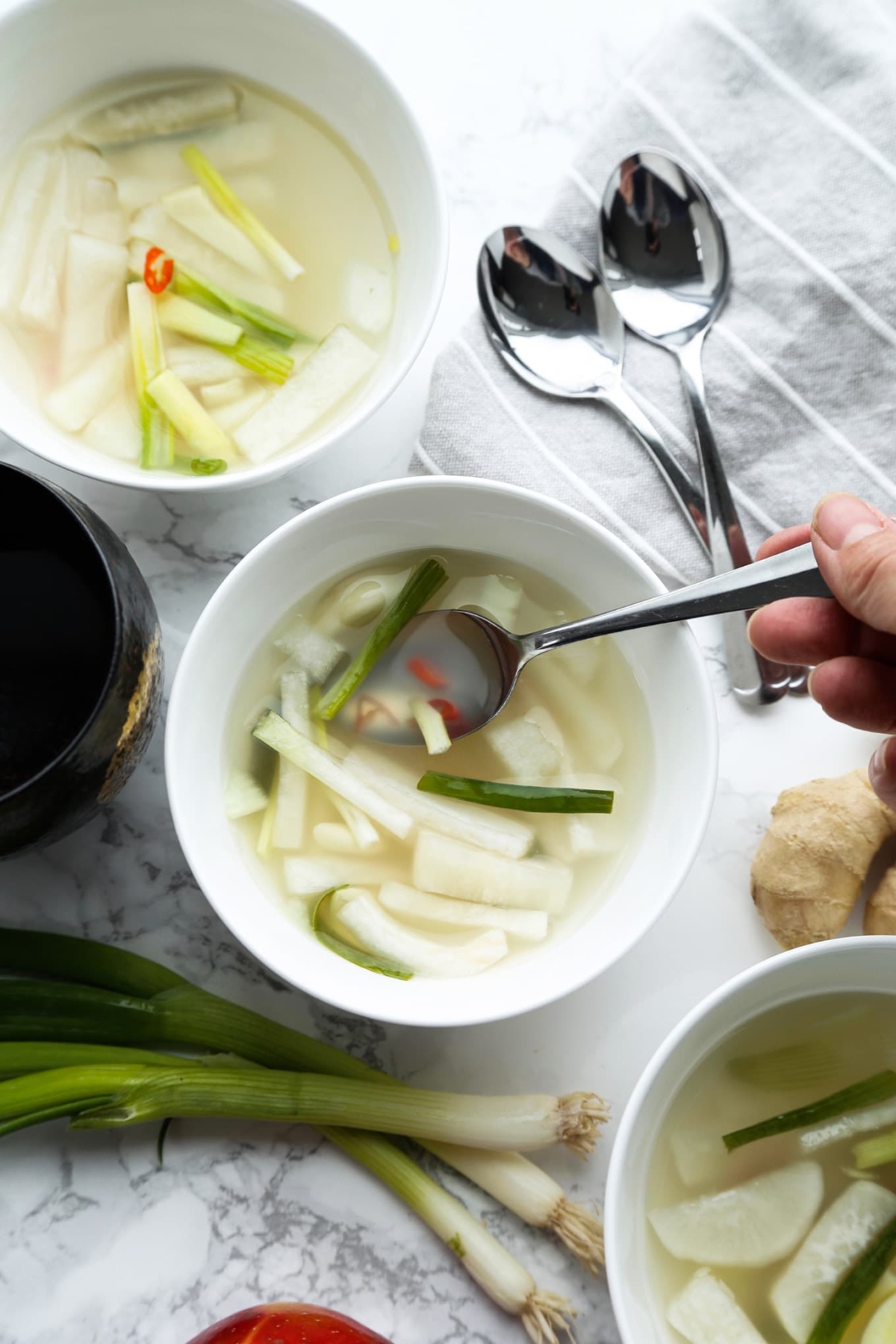
Dongchimi (Korean Radish Water Kimchi)
I love any pickle recipe where the brine is as important as the pickled veggies themselves. Asian pear, garlic and ginger all take a turn flavoring the brine – which is a simple mixture of water, salt and sugar. Once the veggies are pickled to your taste, they are meant to be served with a healthy amount of brine. Bonus: you can also use the brine when making a cold Korean noodle dish called naengmyeon (more on that in a sec).

The Best Vegan Kimchi – 김치
Oooh… Here’s the one banchan we all know and love! Kimchi is a fermented food that has a legendary amount of pungent, bright and smoky spice. This vegan kimchi is predominantly made of napa cabbage and scallions (but you can use other veggies). And while there are quite a few steps to this popular Korean recipe, none of them are difficult. The hardest part is waiting the two days for the fermentation process to complete – staring into the fridge with hungry eyes.

Vegetarian Kimbap (Gimbap)
This is a Korean classic. Loaded with strips of egg and vegetables like carrots, cucumbers and danmuji (yellow pickled daikon), these Korean rice rolls make the best lunch or midnight snack. The key is the rice. You’ll want to lightly season it with sesame oil before rolling everything up in a thin sheet of toasted seaweed.

Scallion Pancakes (Pajeon – 파전)
These crispy, chewy Korean scallion pancakes are seriously addictive. You’ll want to use a combination of rice flour and all purpose flour in the batter to really nail the texture. And I’ve got a simple soy sauce, rice vinegar, honey and gochugaru based dipping sauce for your pa jun that takes the whole thing to the next level!
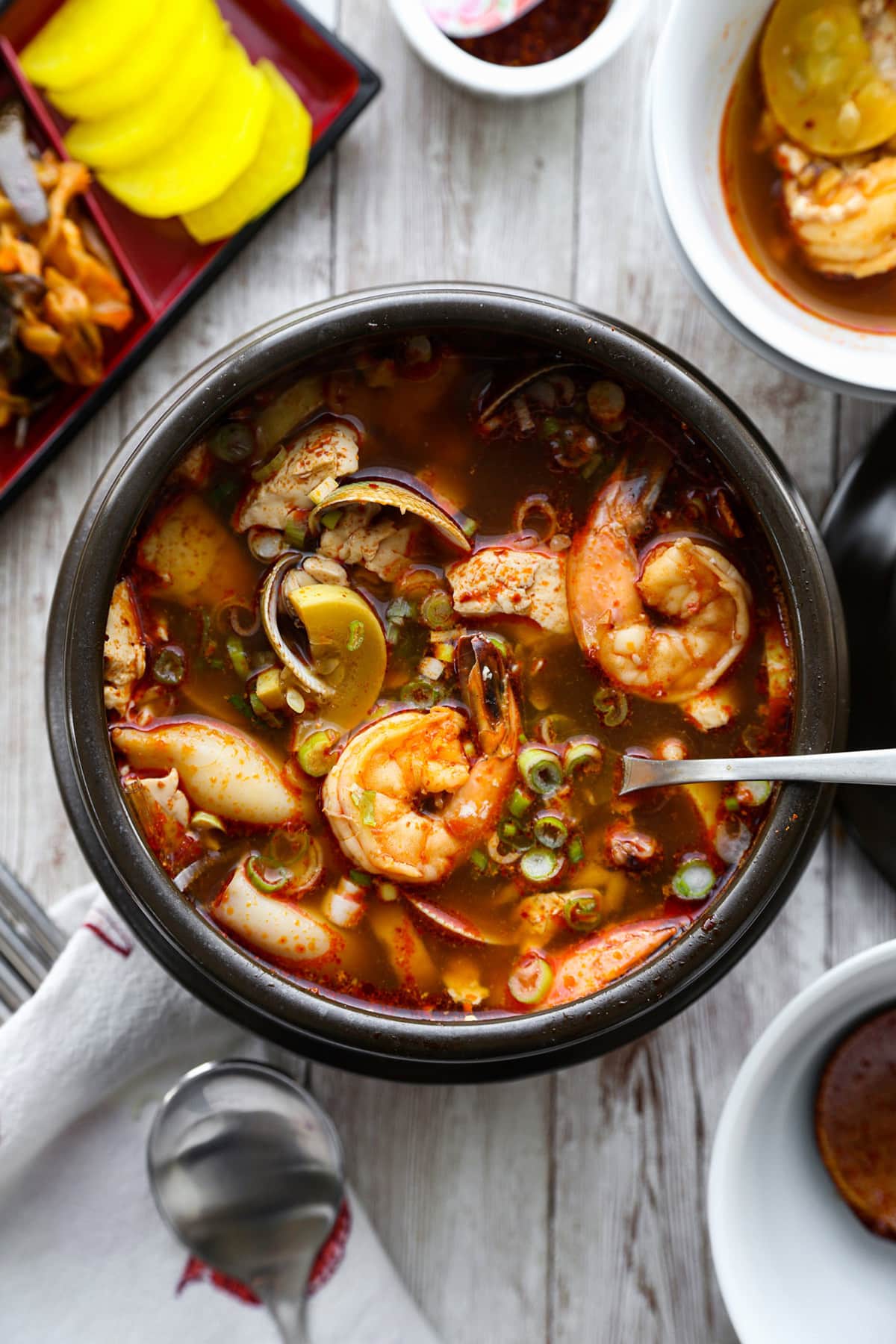
Soondubu Jjigae (Korean Spicy Tofu Stew)
When it comes to soondubu, you probably first think about the bean curd. That’s because silken tofu is a must when it comes to this traditional Korean stew. However, I’ve always been a huge fan of adding seafood to soondubu jjigae. The marine tasting notes elevate the smoky spiciness to something truly next level. And, if it’s cold outside, soondubu makes the best comfort food!
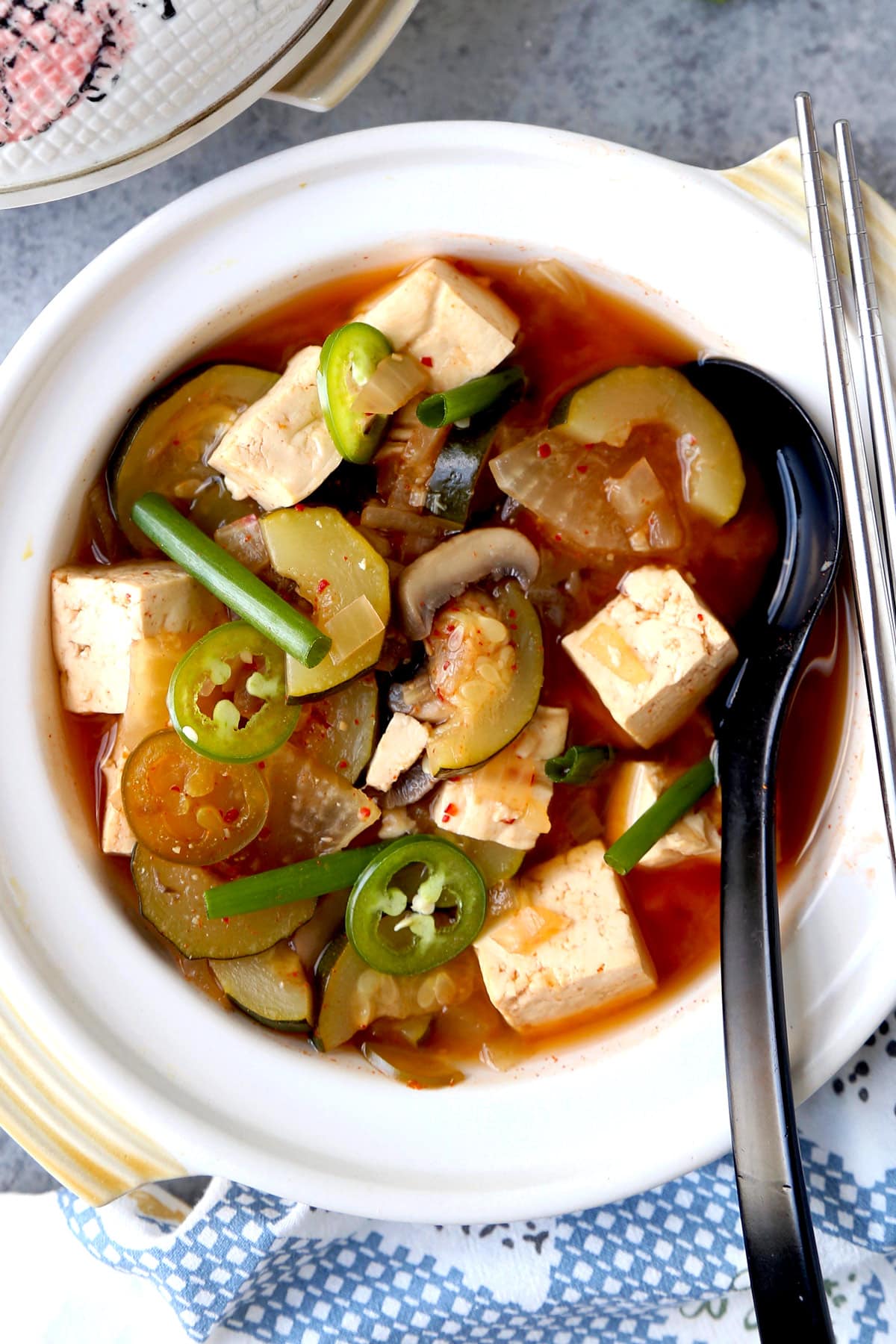
Doenjang Jjigae (Korean Soybean Paste Stew)
Similar in many ways to soondubu (i.e. lots of tofu!), this Korean stew gets legions of earthy, savory flavor from a soybean paste called doenjang (된장). I like using daikon radish, mushrooms and sliced zucchini in this veggie loaded stew – but fee free to use what you’ve got handy. Spice lovers will definitely want to add a fresh chili pepper or two.
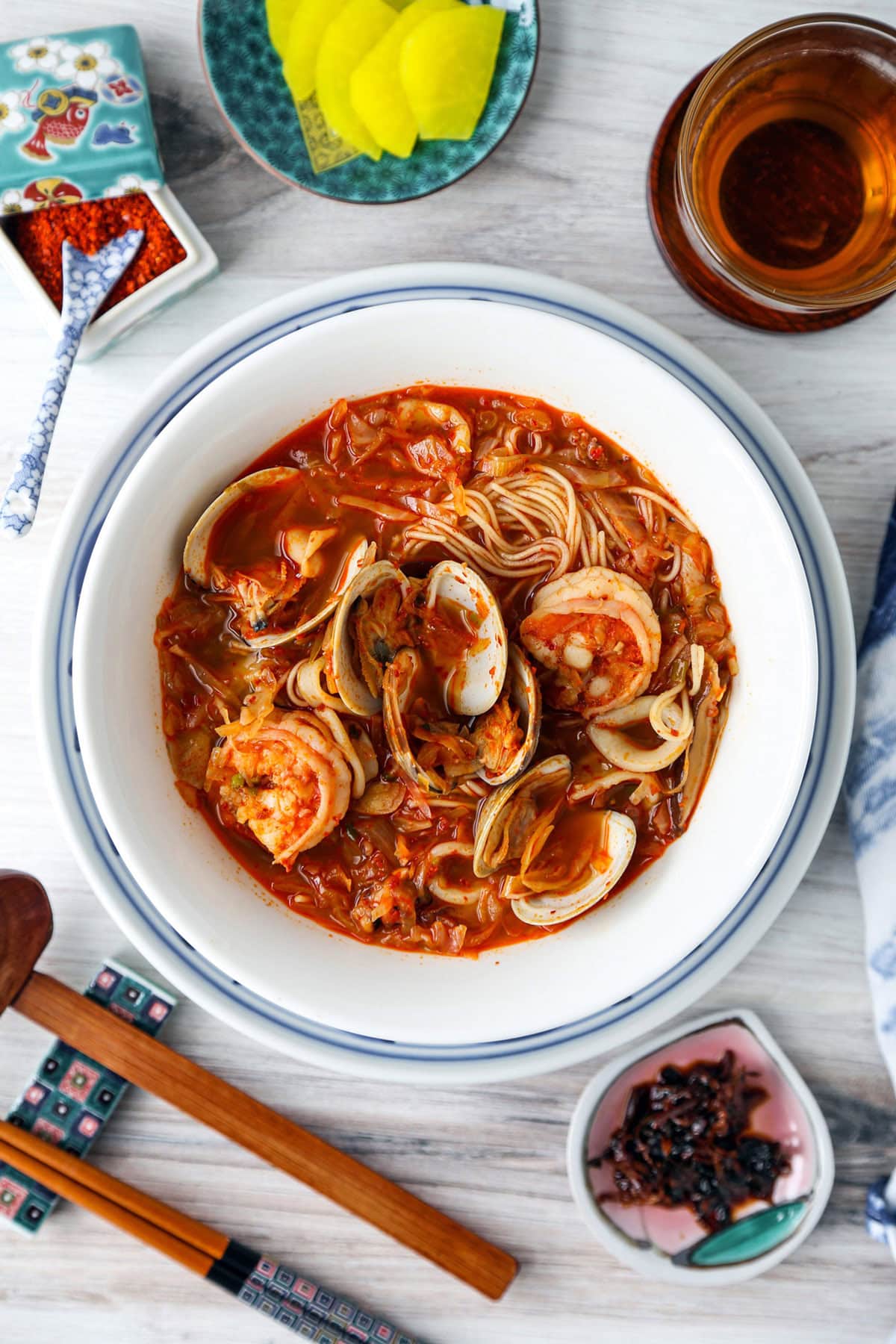
Jjamppong (Korean Spicy Seafood Noodle Soup)
Jjamppong is Korea’s favorite smoky, spicy, and briny seafood noodle soup! Packed with shrimp, squid and clams, it’s comforting and filling enough to be served as a main. Move over ramen – this Korean noodle soup is ready in about 30 minutes from start to finish.
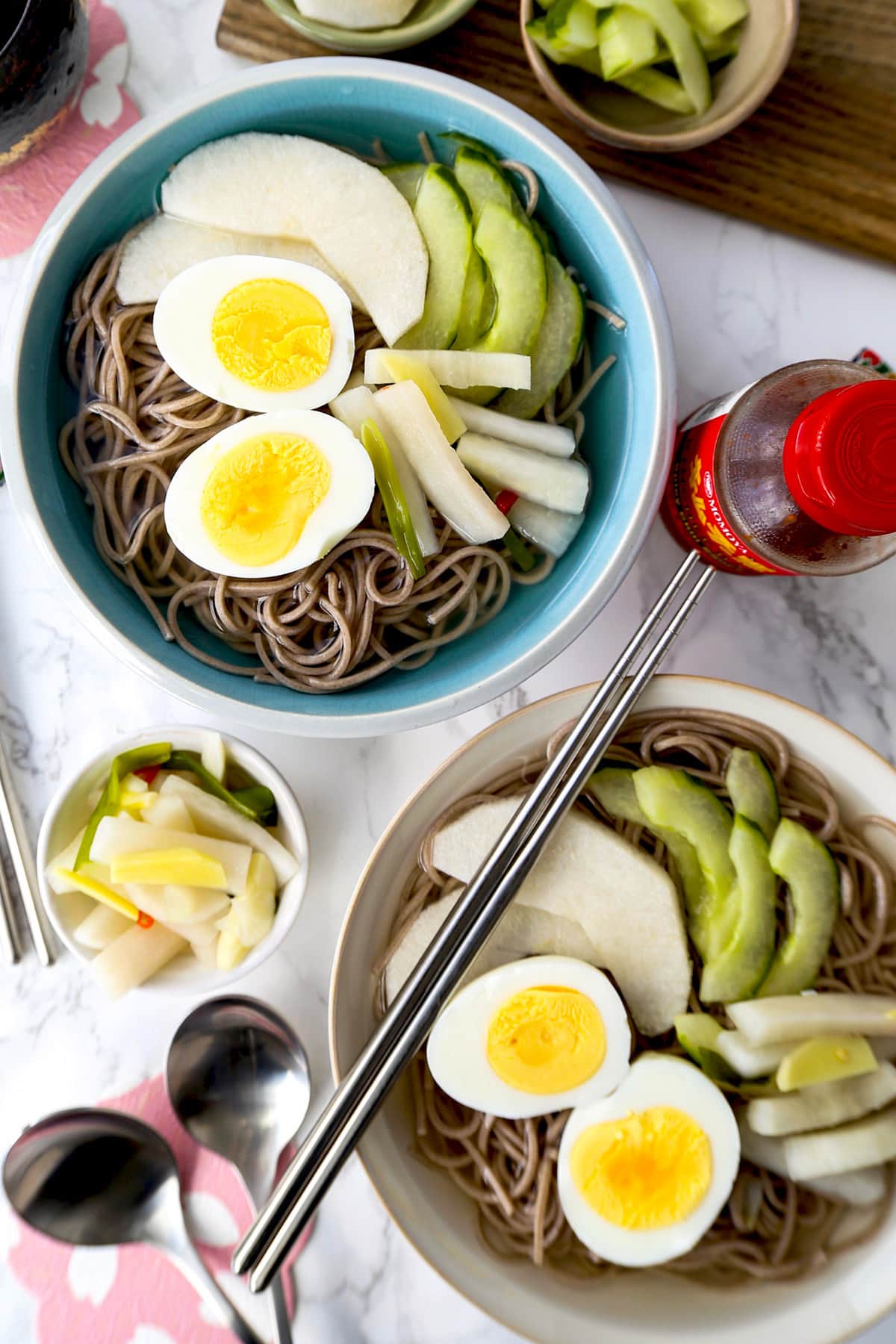
Naengmyeon – 냉면 (Korean Cold Noodles)
This delicious Korean recipe finds its peak popularity when the summer temperatures soar. But this salty, sour, pickle-y buckwheat noodle soup is delicious anytime of the year. The secret to this cold soba recipe is having plenty of dongchimi on hand.

Japchae (Korean Glass Noodles)
Chewy glass noodles and colorful veggies tossed in a sweet and savory sauce… yep, there’s a lot to love when it comes to japchae. Glass noodles (dangmyeon – 당면) are made from sweet potato starch and are super easy to prepare. This is one of my favorite vegan Asian noodle recipes of all time.

Vegan Jajangmyeon (Korean Noodles With Black Bean Sauce)
Speaking of Korean vegan noodles, you won’t miss the meat at all with this plant based jajangmyeon. This Korean classic relies on chunjang, a fermented black bean paste for an assertive depth of flavor. And I’m using zucchini, mushrooms, celery and cabbage for both flavor and texture. It’s an absolute winner!
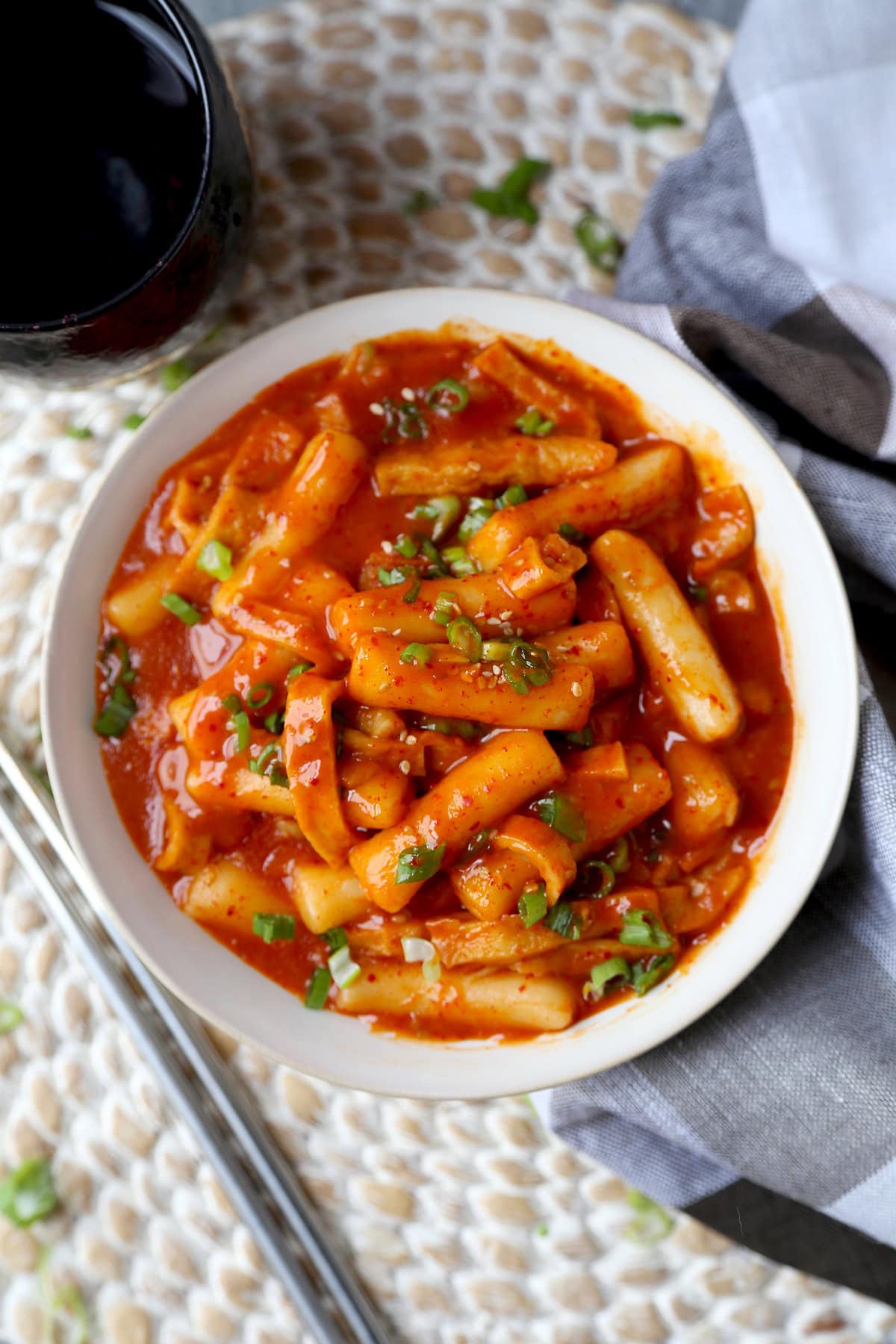
Tteokbokki (Dukbokki) – 떡볶이
Loaded with rice cakes, fish cakes and a whole lotta fire – tteokbokki is Korean street food at its best. But whether you’re at a food stall at 2AM after a night of drinking soju, or just sitting around the dinner table with family on a random Tuesday, the perfect chew from these rice cakes will have everyone grinning from ear to ear.
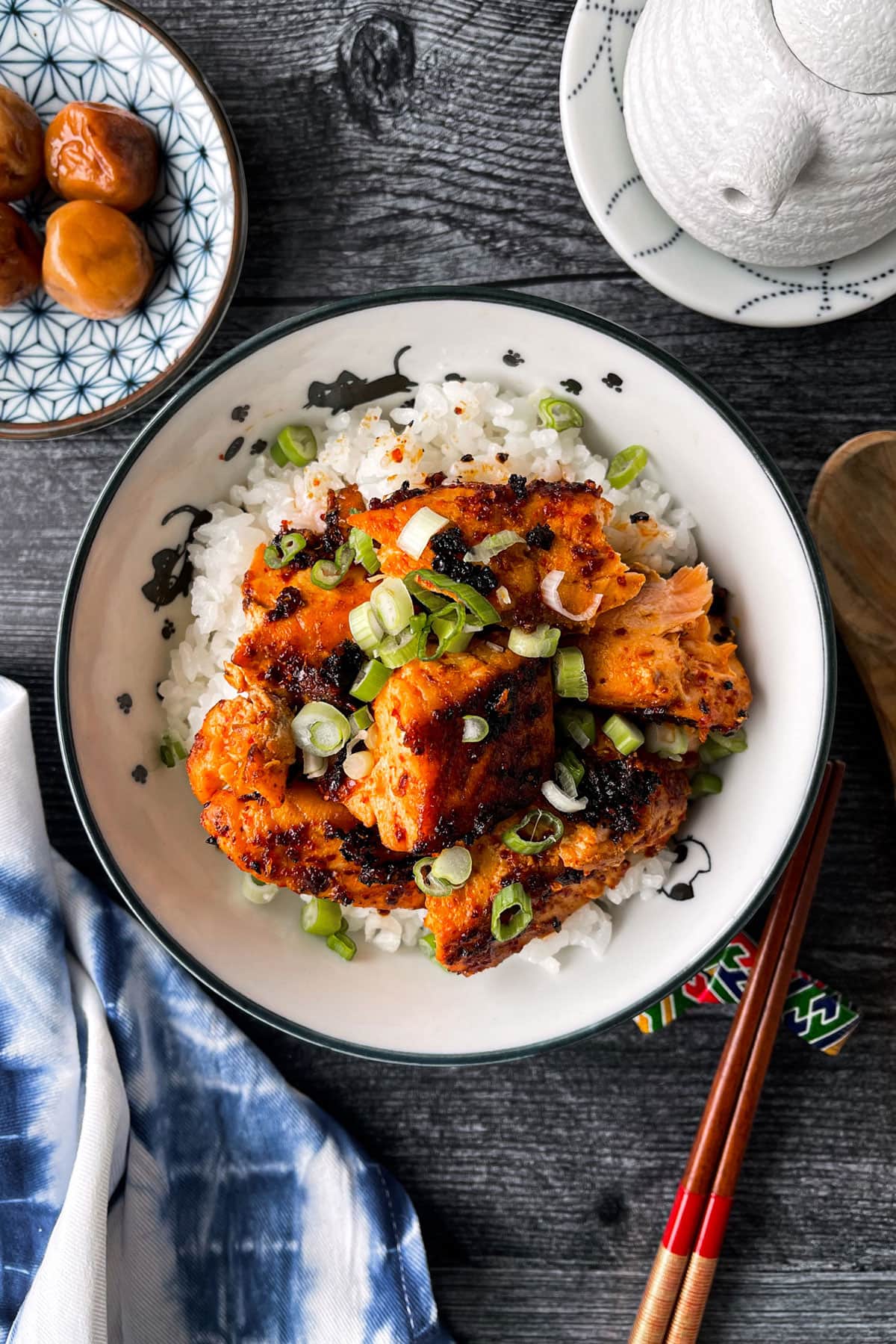
Korean Style Fish Donburi Bowl
Sure, donburi is actually a Japanese thing. But the flavor profile of this spicy, smoky fish over rice recipe is all Korean. Gochugaru and fresh ginger bring the burn, without being volcanic about it. And sesame oil, soy sauce and mirin balance the whole thing out perfectly.
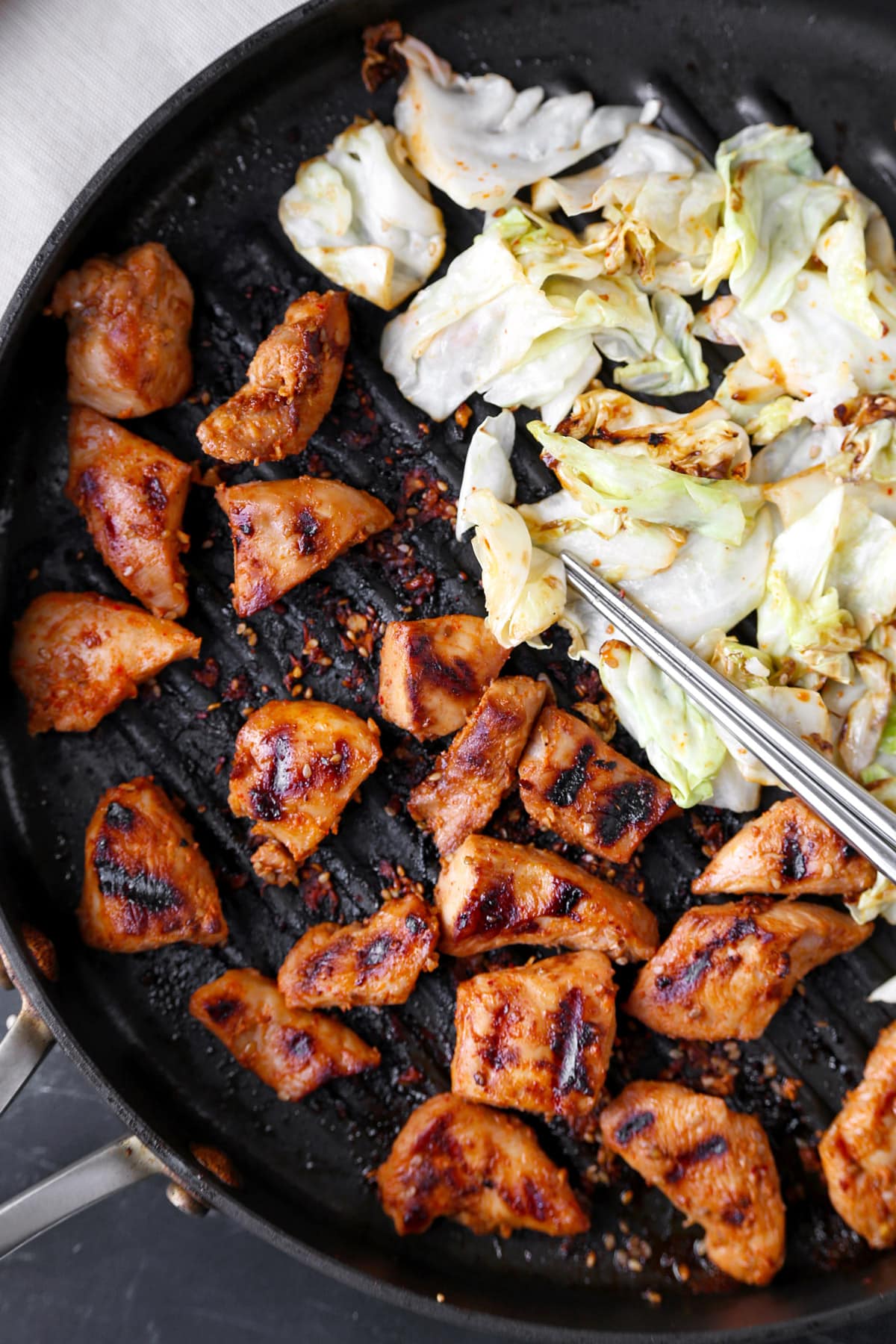
Chicken Bulgogi With Cabbage
Break out the grill pan! Now, yeah, bulgogi is typically made with beef or pork grilled over an open flame. That said, I’m using chicken (and I don’t allow open flames on my dining room table), but the flavor is all there. The secret is the marinade which elevates the chicken to something spectacular in a relatively short amount of time. It’s delicious prepared in a grill pan – but if you have a proper outdoor grill, (omg) you’re in for a treat.
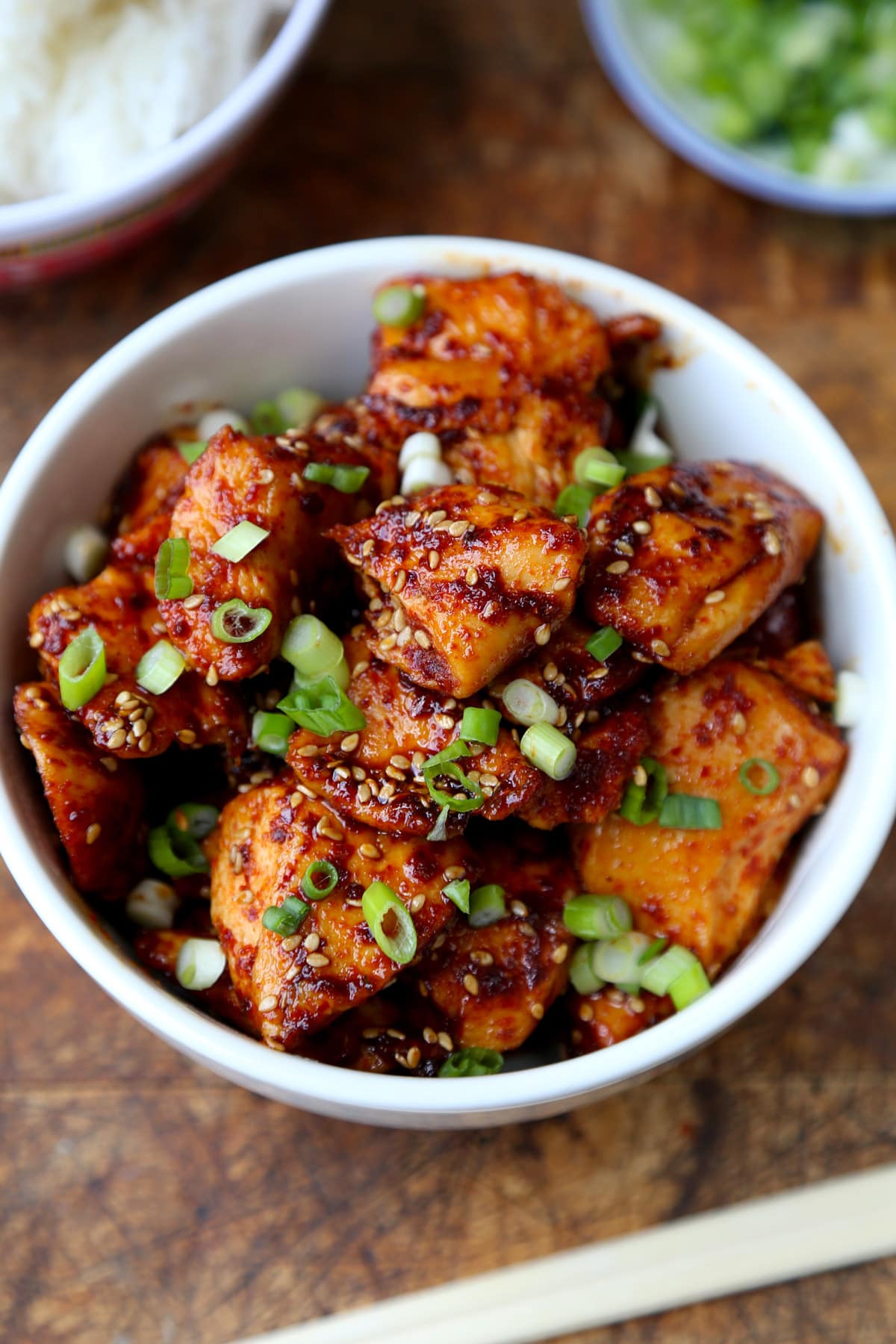
Korean Sticky Chicken
Is there anything better than spicy Korean chicken? If your answer is, “not really,” then this one is for you! Honey and gochugaru bring that sweet heat – while sesame seeds provide a toast-y nuttiness. This one is a winner at dinnertime (and I’ll teach you a technique for infusing spicy flavor into proteins like chicken in no-time-flat).
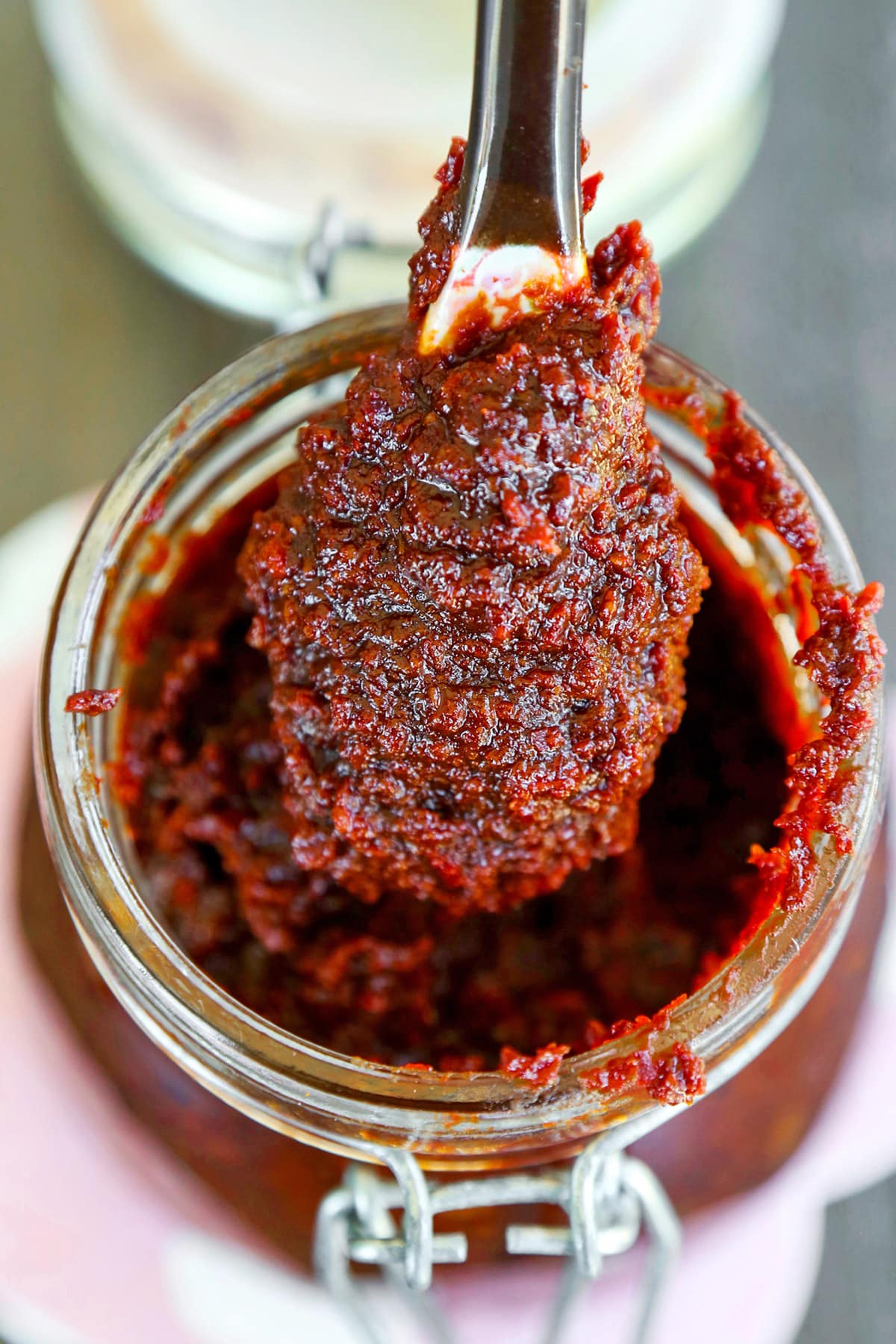
Quick Homemade Gochujang (Korean Chili Paste)
When it comes to Korean recipes, you’ll see gochujang come up a lot. It’s a red pepper paste made of fermented soybeans, chili powder, glutinous rice and salt. And while gochujang is currently enjoying its moment in the sun as the IT-condiment available at almost every grocery store (a la sriracha a few years ago), you can actually make a homemade version rather easily. No fermentation required!
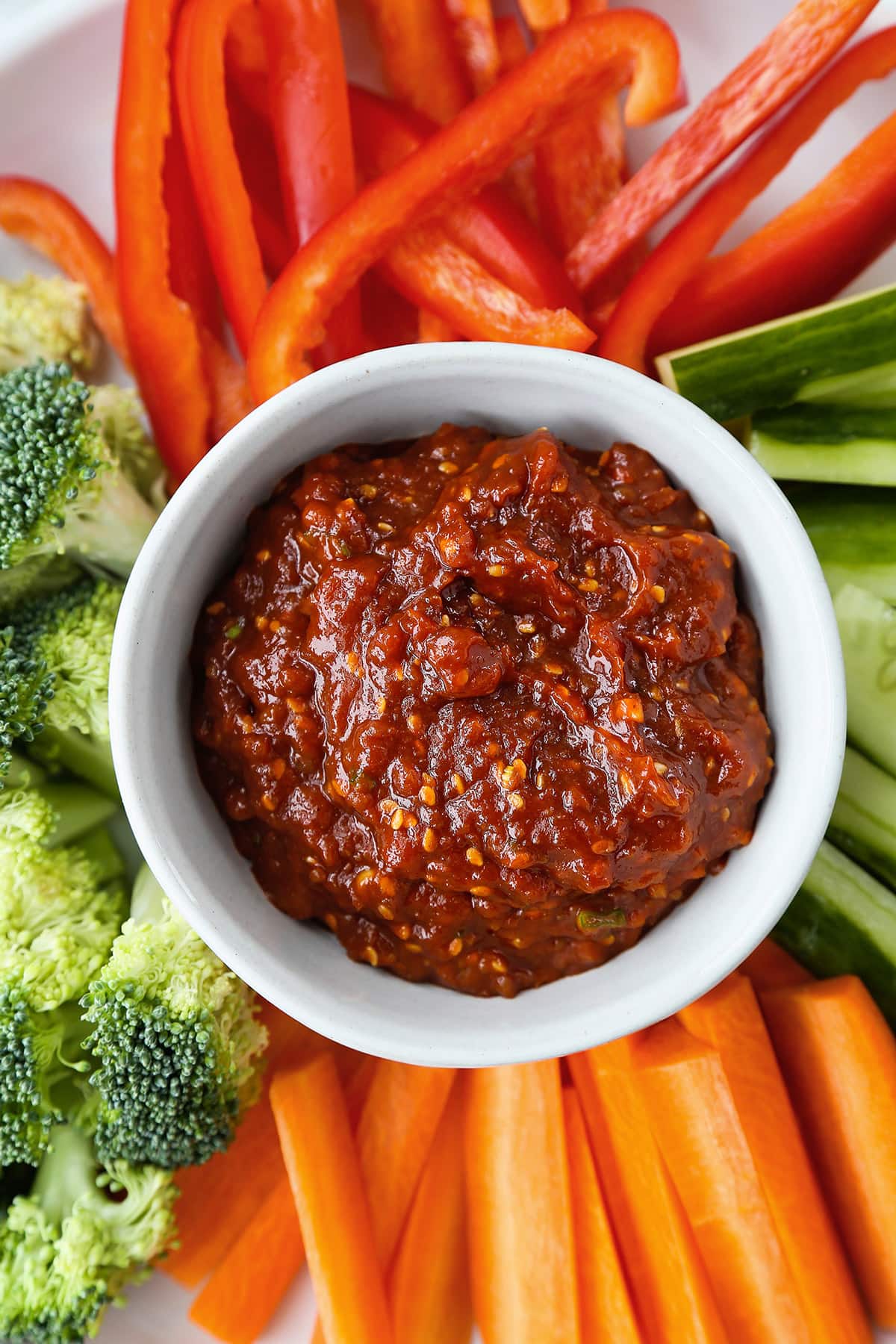
Ssamjang (Korean Dipping Sauce)
If someone asked me to summarize ssamjang in three words or less, I’d say: Korean BBQ Sauce. But it’s way more than just a condiment for galbi wrapped in lettuce or parilla. Savory, earthy and mildly sweet this is one all-purpose condiment you can use for anything from a veggie platter at a dinner party – to chicken nuggets in front of the TV for the kids. My favorite dipping sauce – and one of the easiest Korean recipes of all time.
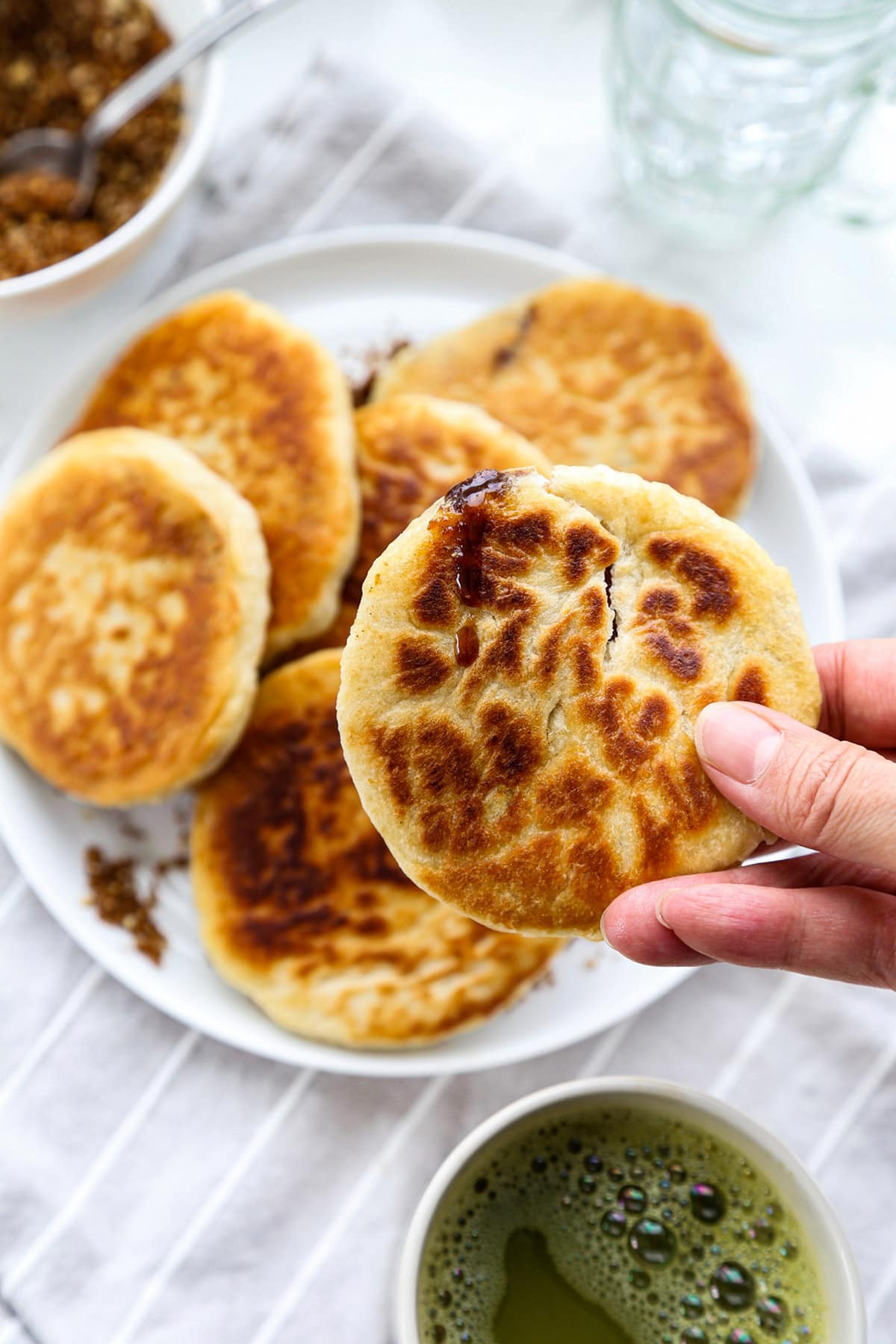
Hotteok – 호떡 (Korean Sweet Pancakes)
Sweet and chewy, hotteok is a popular street food that’s enjoyed all over South Korea. Pan fried pockets hiding a mixture of dark brown sugar, cinnamon and nuts, they kinda remind me of a cinnamon bun minus the glaze. When it comes to this sweet Korean classic, one thing is sure – it’s absolutely delicious!
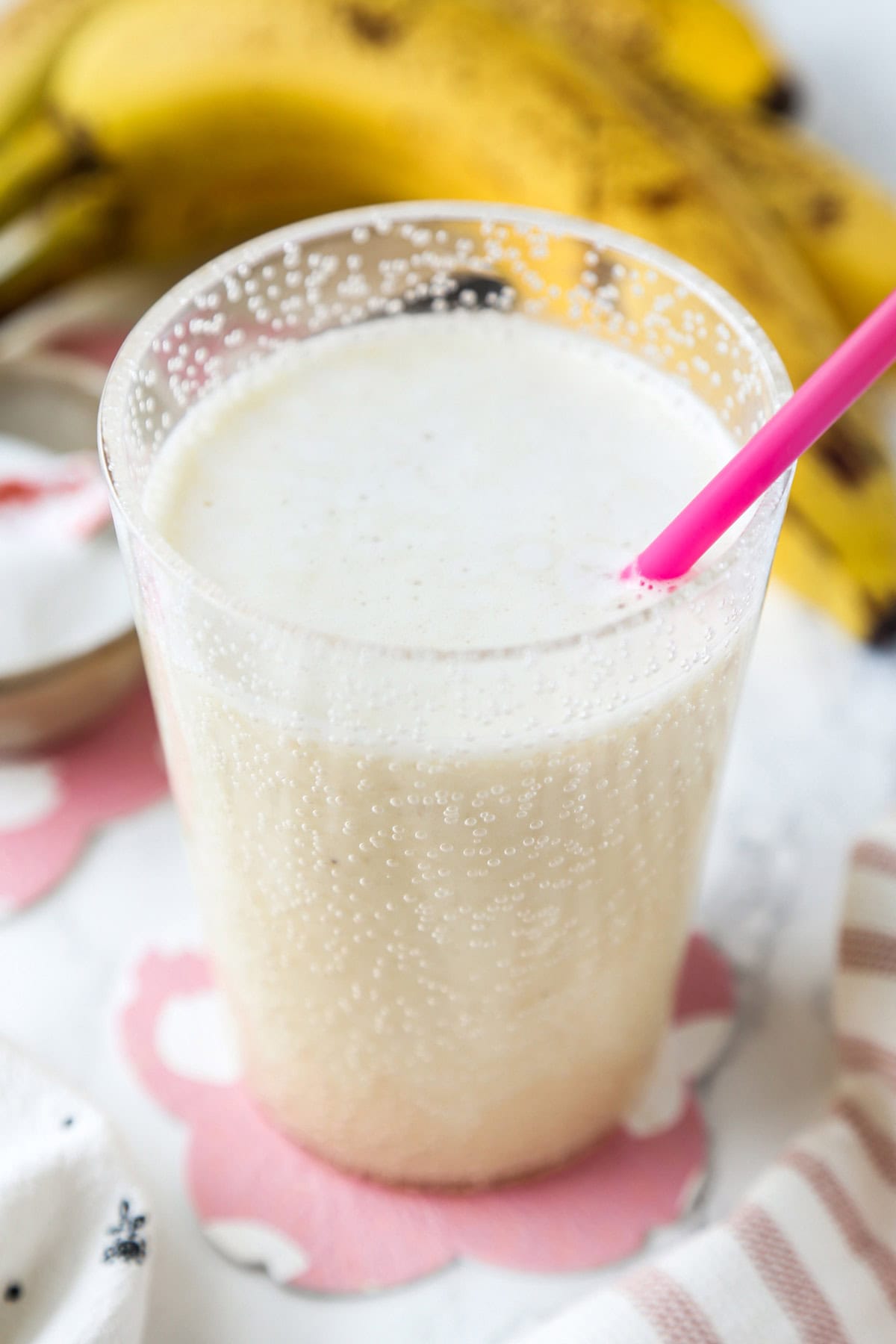
Korean Banana Milk – 바나나 우유
Need a little dessert in your life? A quick breakfast? A mid-afternoon pick-me-up? Mildly sweet and SO refreshing, Korean banana milk makes the perfect treat no matter when you enjoy it. Bonus: this easy Korean recipe only requires 4 ingredients – and it works perfectly with traditional dairy or your favorite plant milk.
Banana Milk Recipe Video
What Korean Ingredients Will I Need?
Much of the flavor in these dishes come from a few key ingredients and master sauces. Now, some of these may already be in your pantry right now.
For example, you probably have sesame oil in your cupboard as we speak. And the recipes for homemade gochujang and ssamjang are above on this page. You can whip those up in no time.
It’s so easy to grab things like gochugaru (crushed Korean chili peppers) on Amazon these days that you can fill out your pantry fairly easily.
Then, when it comes to the actual preparation, you’ve got this. Happy cooking!

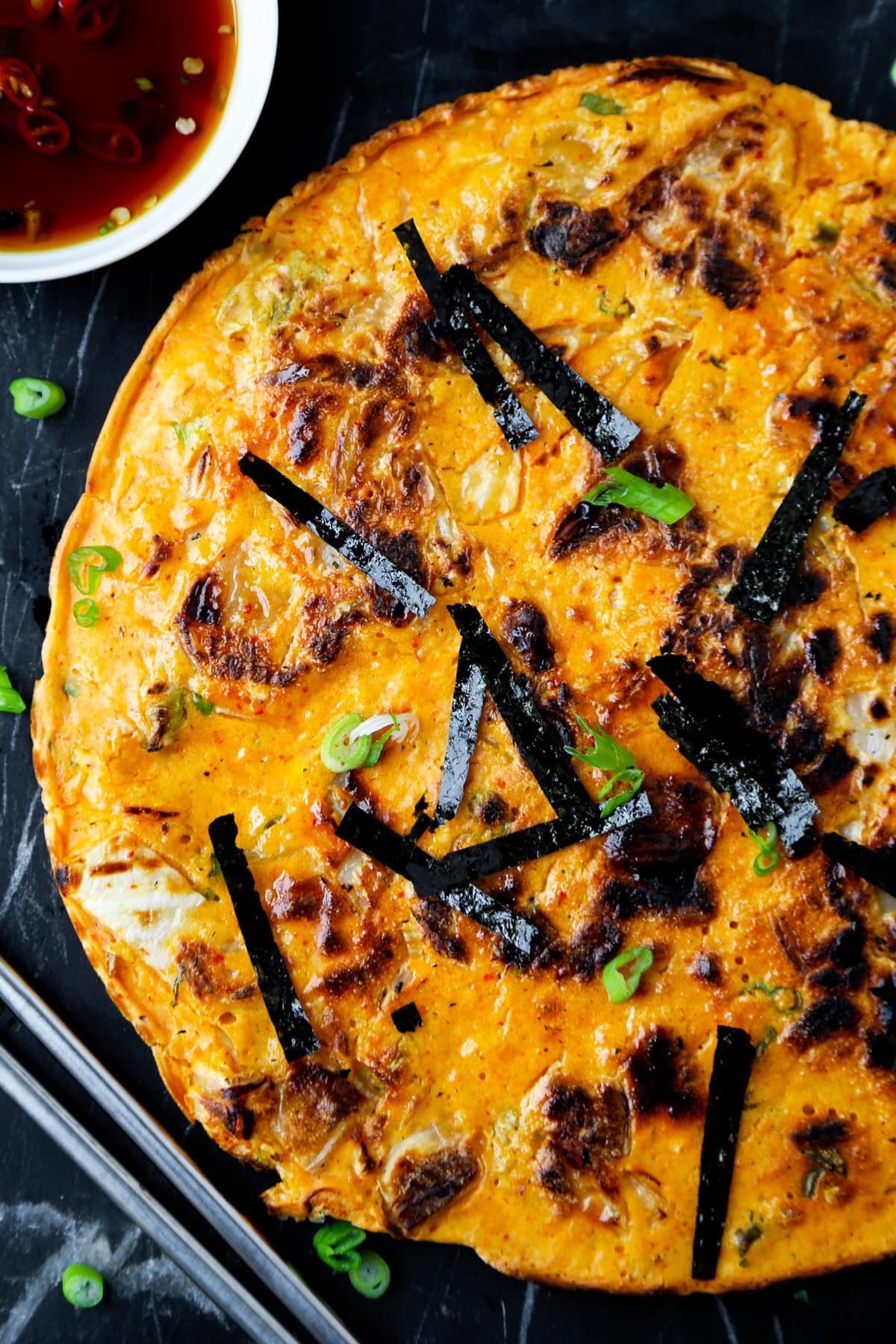
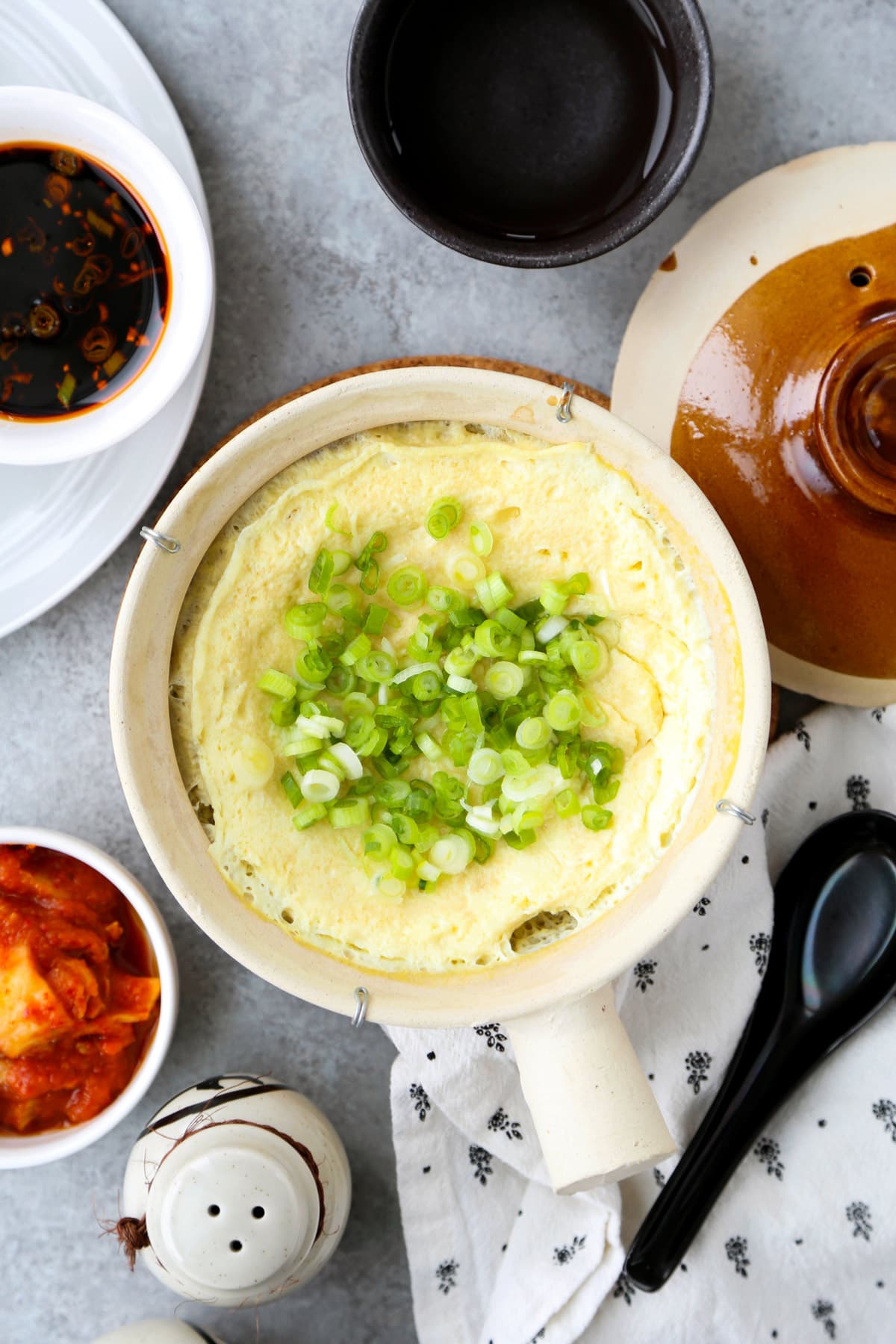
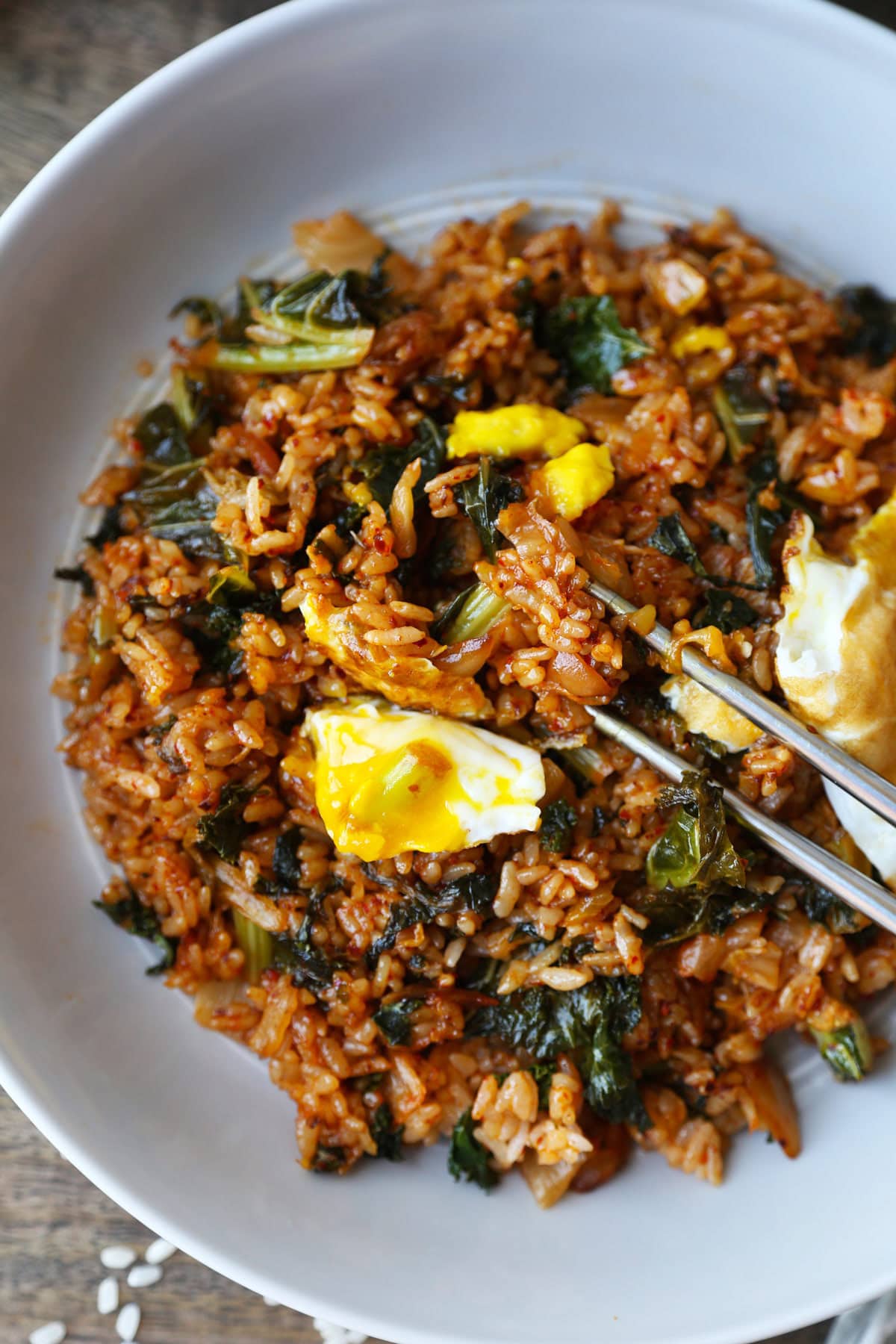
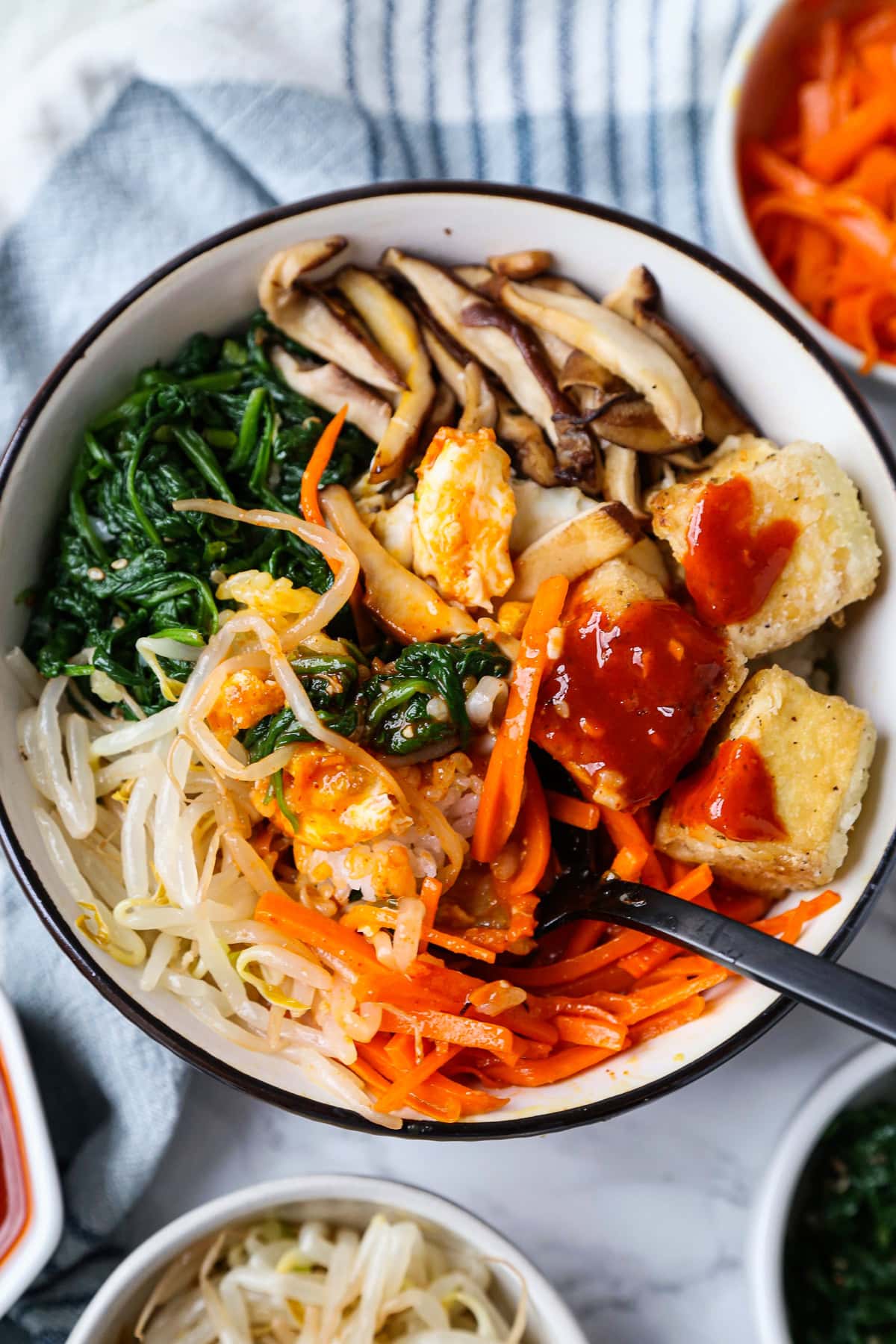
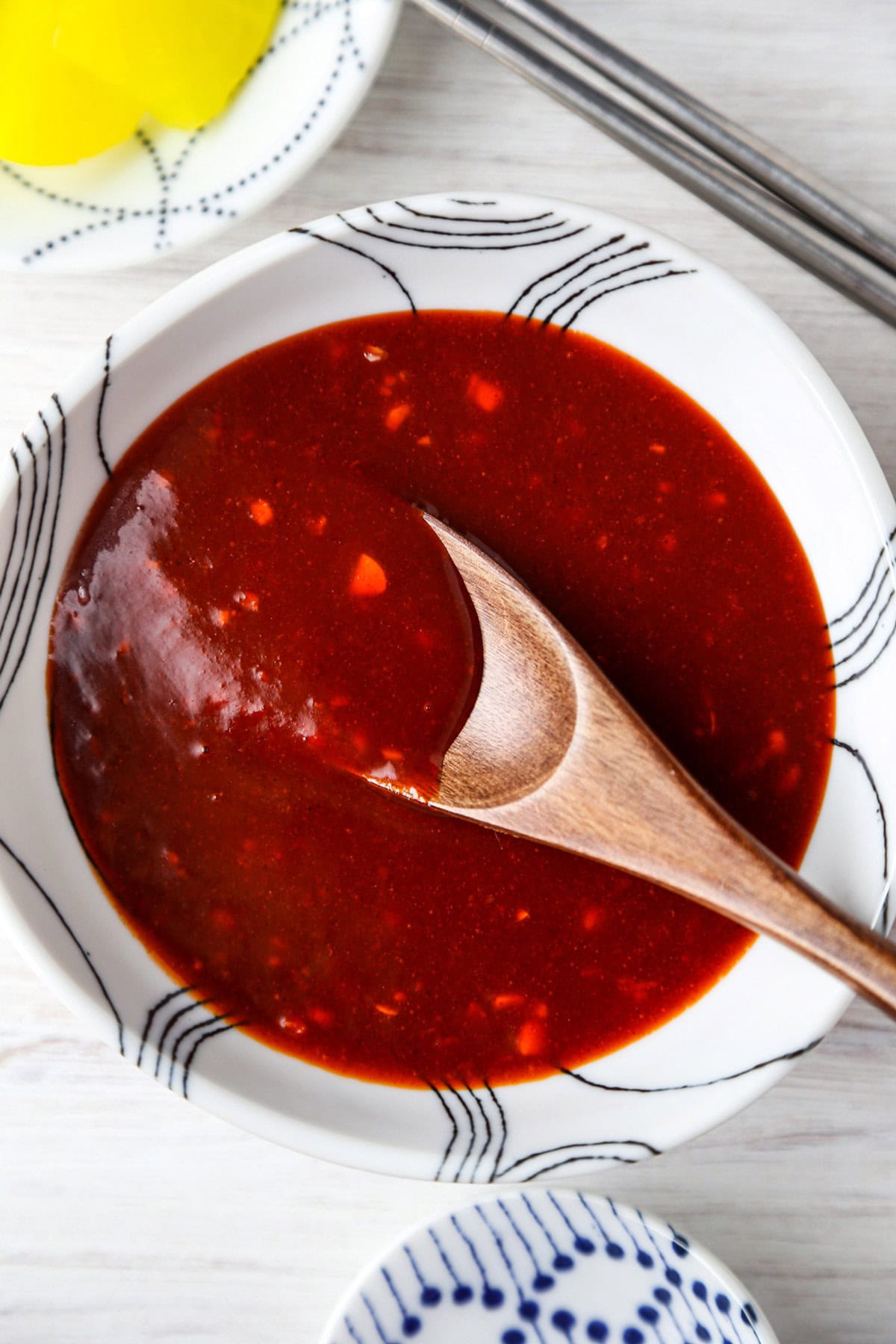















Looks for easy and delicious
Thanks